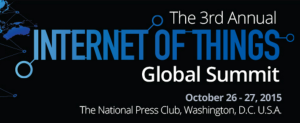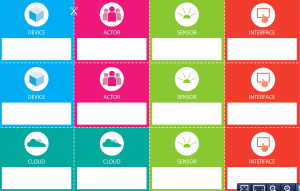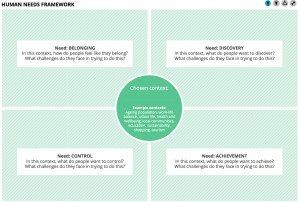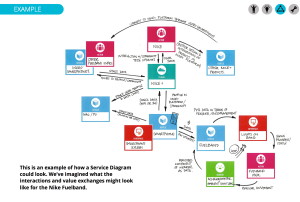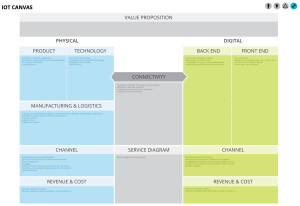Fasten your seatbelts! I think I’ve finally zeroed in on the Internet of Things’ (IoT’s) most important potential economic benefit and how it could simultaneously help us escape the growing global environmental crisis:
make real-time IoT data* the hub of a circular economy and management mentality. It’s both good for the bottom line and the planet.
I started writing about circular business models back in the 90’s, when I consulted on profitable environmental strategies, i.e., those that were good both for the corporate bottom line and the planet. It galled me that executives who railed about eliminating inefficiency thought reducing waste was for tree-huggers. Semantics and lifestyle prejudices got in the way of good strategy.
I could see that it was vital that we get away from old, linear models that began with extracting resources and ended with abandoned products in landfills. Ford’s massive 1 x 1.6 mile River Rouge Plant, the world’s largest integrated factory, was the paradigm of this thinking: ore was deposited at one end, made into steel, and cars came out the other (Hank’s penchant for vertical integration even led him to buy rubber plantations! If you have any illusions about the ultimate impossibility of top-down control, watch the PBS documentary on Ford — he simply couldn’t share power, even with his own son — and it almost ruined the company). The linear model worked for a long time, and, truth to tell, it was probably the only one that was feasible in the era of paper-and-pencil information flow: it was so hard to gather and transmit information that senior management controlled who got what information, and basically threw it over the transom to the next office.
As for any kind of real-time information about what was actually happening on the factory floor: fugetaboutit: all that was possible was for low-level functionaries to shuffle along the assembly line, taking scheduled readings from a few gauges and writing them on a clipboard. Who knew if anyone ever actually read the forms, let alone made adjustments to equipment based on the readings?
Fast forward to 2015, and everything’s changed!
The image of the circular corporation popped back into my head last week while I was searching for an image of how the IoT really can change every aspect of corporate operations, from product design to supply chain management. I was happily surprised that when I Googled “circular economy” I found a large number of pieces, including ones from consulting gurus Accenture and McKinsey (the most comprehensive report on the concept is probably this one from the Ellen MacArthur Foundation), about the bottom-line and environmental benefits of switching from a linear (‘take-make-dispose’) pattern.
But how to make the circular economy really function? That’s where the IoT comes in, and, in my estimation, is THE crucial element.
Visualize everything a company does as a circle, with IoT-gathered real-time data as its hub. That’s crucial, because everything in a profitable circular company revolves around this data, shared in real time by all who need it.
When that happens, a number of crucial changes that were impossible in the era of linear operations and thinking and limited data became possible for the first time:
- you can optimize assembly line efficiency because all components of the factory are monitored by sensors in real time, and one process can activate and regulate another, and/or managers and assembly-line workers can fine-tune processes (think of the 10,000 sensors on the GE Durathon battery assembly line).
- you can integrate the assembly line with the supply chain and distribution and sales network as never before (provided that you share the real-time data with them), so materials are delivered on a just-in-time basis) and production is dictated by real-time data on sales (the SAP smart vending machine, integrated with logistics, is a great example).
- you can optimize product redesign and upgrades and speed the process, because sensor data from the products as they are actually used in the field is immediately fed back to the designers, so they have objective evidence of what does, and doesn’t work properly (think of how GE has improved its product upgrade process). No more ignorance of how your products are actually used!
- from an environmental standpoint, having sensors on key components can make it possible for you to recover and profitably remanufacture them (closing the loop) rather than having them landfilled (I was excited to learn that Caterpillar has been doing this for 40 years (!) through its Reman Program, which “reduces costs, waste, greenhouse gas emissions and need for raw inputs.”).
- you can create new revenue streams, by substituting services for actual sales of products. I’ve written before about how GE and RollsRoyce do this with jet engines, helping clients be more efficient by providing them with real-time data from jet turbines in return for new fees, and Deere does it with data feeds from its tractors. Now I learn that Phillips does this, with industrial lighting, retaining ownership of the lighting: the customers only pay for the actual use of the lights. Phillips also closes the loop by taking the lights back at the end of their life and/or upgrading them.
As I’ve written before, creating the real-time data is perhaps the easier part: what’s harder is the paradigm shift the circular economy requires, of managers learning to share real-time data with everyone inside the enterprise (and, preferably, with the supply chain, distribution network, retailers, and, yes, even customers). When that happens, we will have unprecedented corporate efficiency, new revenue streams, satisfied customers, and, equally important reduce our use of finite resources, cut pollution, and tread lightly on the earth. There you have it: the secret to 21st-century profitability is:
real-time IoT data, at the hub of the circular enterprise.
*Oh yeah, please don’t drop a dime on me with the grammar police about the title: in fact, I’m a retired colonel in the Massachusetts Grammar Police, but I’ve given up the fight on “data.” From my Latin training, I know that data are the plural form of datum, but datum is used so infrequently now and data with a singular verb has become so common that I’ve given up the fight and use it as a singular noun. You can see the issue debated ad nauseum here …

